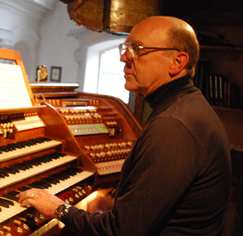After their annual descent into the orchestral pit at Belk Theatre for Charlotte Ballet’s Nutcracker, the Charlotte Symphony Orchestra is dancing into 2019, emerging at Knight Theater for a program that is headlined by Rachmaninoff’s Symphonic Dances and Prokofiev’s Third Piano Concerto. Tipping the balance decisively toward dance, “The Chairman Dances,” by John Adams opened the evening. Although the Charlotte debut of Gabriela Montero had been scheduled, the Venezuelan pianist sent her regrets a while ago so that Lukáš Vondráček had been announced as her replacement back in December. Vondráček was making his third appearance with the orchestra, his 2013 debut in Liszt’s Piano Concerto No. 2 having been followed by another Charlotte Symphony first – the Shostakovich Concerto for Piano and Trumpet in 2015.
Music director Christopher Warren-Green prefaced “The Chairman Dances” by perfectly reciting the potential scenario from Adams’ opera, Nixon in China, that inspired it. One startling description followed another, most arrestingly when Madame Mao, after crashing a presidential banquet for the visiting Nixon, strips down to a cheongsam (a skin-tight bodysuit with a slit from ankle to hip). More surreal than that, but justifying Adams’ “Foxtrot for Orchestra” subtitle, Chairman Mao comes to life, steps out of his official portrait hung on the wall and dances with his wife. If the music itself were only half as seductive and sensational as this scenario, it would be unforgettable. Under a repetitive, mechanical melody line from the strings, the vitality of this piece came from the angular, irregular, and unpredictable pulse of the percussion. Wood blocks, tubular bells, and a snare drum were heard from the upstage, but perhaps the oddest contribution came from Andrea Mumm Trammell, raking the smallest strings of her harp. A steady drone from the woodwinds seemed to taper the strings’ relentless momentum, and a drum kit intruded before the music swelled and slowed.
The first episode that chimed for me with the scenario that inspired Adams was the entrance, like a whale or an elephant, of the trombones and tuba – perhaps signaling the moment when Mao steps out of his portrait? The serene segment that followed, with truly soothing violins and fluid melody, was the first to be more danceable for intimate humans than for robots. Neither the opening minimalism nor the climactic foxtrot would prepare the listener for the quiet conclusion of his “Dances,” as the instrumentation thinned out from French horns and high violins to piano and the kick pedal of the drum kit before a final whimper from the wood blocks brought the machine to a standstill. Adams was either emptying out the banquet hall or transporting us to an earlier time when the couple danced alone.
With no fewer than four recordings in my CD collection, the Prokofiev Piano Concerto No. 3 in C is a favorite of mine. What sounds blissfully familiar to me, however, may have struck subscribers as pleasantly exotic and surprisingly accessible. My previous review of a local performance of the piece dates back to 1999 when the guest soloist was Christopher O’Riley, whom I could fault only for making his solos sound too lucid and cohesive. Vondráček’s account had more of the wildness and spontaneity I crave, without sacrificing Prokofiev’s seductiveness when it was called for.
Warren-Green and his orchestra were wonderfully attuned to the charms and colors of this piece. Each of the three movements makes an almost instant impression. There’s an enticingly lyrical intro to the opening Andante-Allegro that called forth some beautiful playing from the woodwinds before they accelerated into the propulsive entrance from the keyboard. Among the perks of this live performance was getting to hear the castanets, usually obscured on recordings, behind the fury of Vondráček’s playing. They spice up the movement until the very end. Another perk was watching Vondráček’s two-fisted attacks on the keyboard, projected on a large screen over the orchestra from a live overhead camera feed, during the majestic build-ups that circled us back to the piano’s opening exclamation. Watching both hands flying in-sync over the keys added to the drama.
The flutes, echoed by the bassoons, were especially piquant in the languid opening to the Andantino middle movement. Vondráček deepened the spell, adding layer upon layer of mystery, though here the systolic shuttling between lyrical and raucous episodes with slow and fast tempos was far more sharply contrasted. The last excursion was such a wild ride that listeners could be forgiven for assuming that we had moved on to the final movement, but the dense orchestral accompaniment to Vondráček’s climactic outburst suddenly evaporated, and the sweet flutes returned with their original theme. When it came, the final Allegro ma non troppo brought us Vondráček’s most rhapsodic playing, alternating with some of his most febrile immersions. The pianist might be limping along one moment and trilling furiously moments later until a final frantic cadenza left the audience breathless and jumping to their feet.
Rachmaninoff’s Symphonic Dances meshed very well with the Prokofiev firestorm, though it never built to the same intensity, even when percussive opportunities were there. On the other hand, the first movement trio, with an alto saxophone joining the oboe and clarinet, stood out for its poignancy. The strings were unusually affecting in this Non Allegro, with Trammell getting to show the lyrical side of her harp and the brass distinguishing themselves in the march. Muted brass stood out in the waltzing middle movement and concertmaster Calin Lupanu had a nice spot as well. Most epic from a symphonic standpoint was the closing movement, though here again, less mellow playing would have pleased me more. The percussive elements of the score finally came through with full ferocity as wood blocks, tubular bells, cymbals, tambourine, and timpani all fired off to cap the evening.
This program repeats Saturday, January 26. See our sidebar for details.












